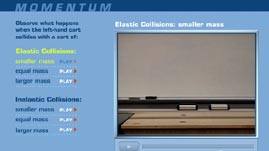Teachers' Domain - Digital Media for the Classroom and Professional Development
User: Preview

Source: Wake Forest University, Department of Physics
In this interactive activity adapted from Wake Forest University, learn about the principle of conservation of momentum. Two carts colliding on an air track demonstrate how momentum is conserved in a closed system. Observe six different scenarios—a moving cart colliding with a stationary cart of lesser, equal, or greater mass in both elastic and inelastic collisions—to see how the motion of the carts changes after each collision.
Momentum Worksheet (Document)
All moving objects have momentum, which describes the amount of motion an object has. Momentum is a vector quantity described by both direction and magnitude. The direction of an object’s momentum is the same as its motion. The magnitude of an object's momentum can be thought of as an indicator of how much effort it would take to bring the object to a stop. For example, imagine a tennis ball and a bowling ball, each rolling at 5 mph. Which ball do you think would be harder to stop?
Because the bowling ball is more massive, it has more momentum and would take more effort to stop. Linear momentum (momentum for an object traveling a straight path) is equal to the product of the object's mass and velocity. In other words, for two objects of different masses moving at the same velocity, the more massive object has more momentum. Similarly, for two objects of the same mass moving in the same direction at different velocities, the object traveling at the higher velocity has more momentum.
The total momentum of a system is the sum of the momentum vectors for each of the objects involved. In a closed system—a system with no outside forces acting on it—momentum is conserved; in other words, the total amount of momentum always remains the same. For example, in the case of two colliding objects, the total momentum of the system before the collision is equal to the total momentum of the system after the collision.
An air track provides a nearly frictionless surface to demonstrate the conservation of momentum in collisions. As a good approximation of a closed system (the carts sit on a cushion of air over the track, which allows them to glide freely without a significant amount of friction acting on them), the total momentum of the carts before and after the collision remains the same.
There are two basic types of collisions: elastic and inelastic. An elastic collision conserves kinetic energy (the energy of motion)—all the kinetic energy of the objects remains as kinetic energy after the collision. Colliding billiard balls are a good example of a nearly perfectly elastic collision—as one billiard ball hits another billiard ball head-on, the first ball comes to rest and the second ball moves off with a velocity nearly equal to the initial velocity of the first ball. However, in an inelastic collision, kinetic energy is not conserved because some kinetic energy is converted into another form of energy such as heat, sound, or light. In a perfectly inelastic collision, the objects end up sticking together, as could happen when snowballs or lumps of clay collide. Nevertheless, as long as it is a closed system, momentum is conserved in both types of collisions.
 Loading Standards
Loading Standards Teachers' Domain is proud to be a Pathways portal to the National Science Digital Library.
Teachers' Domain is proud to be a Pathways portal to the National Science Digital Library.
